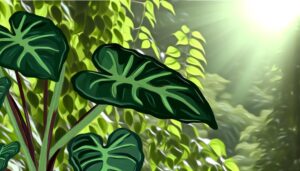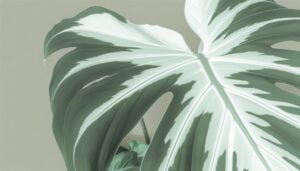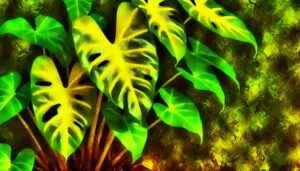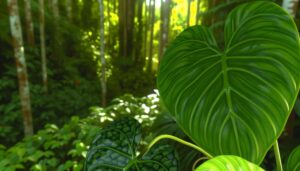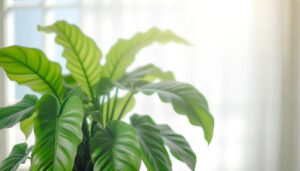Why Are My Philodendron Hope Leaves Curling?
Leaf curling in your Philodendron Hope can be caused by several factors. Improper watering—either overwatering or underwatering—disrupts root function and nutrient uptake.
Low humidity increases transpiration, leading to curling. Both extreme temperatures and inadequate light can also cause stress, manifesting as leaf curling.
Soil must have proper drainage and retain moisture, while a lack of essential nutrients like nitrogen can impair growth. Additionally, pest infestations, such as spider mites, and diseases like fungal infections can further contribute to this issue.
Understanding and addressing each of these factors is key to restoring your plant's health.
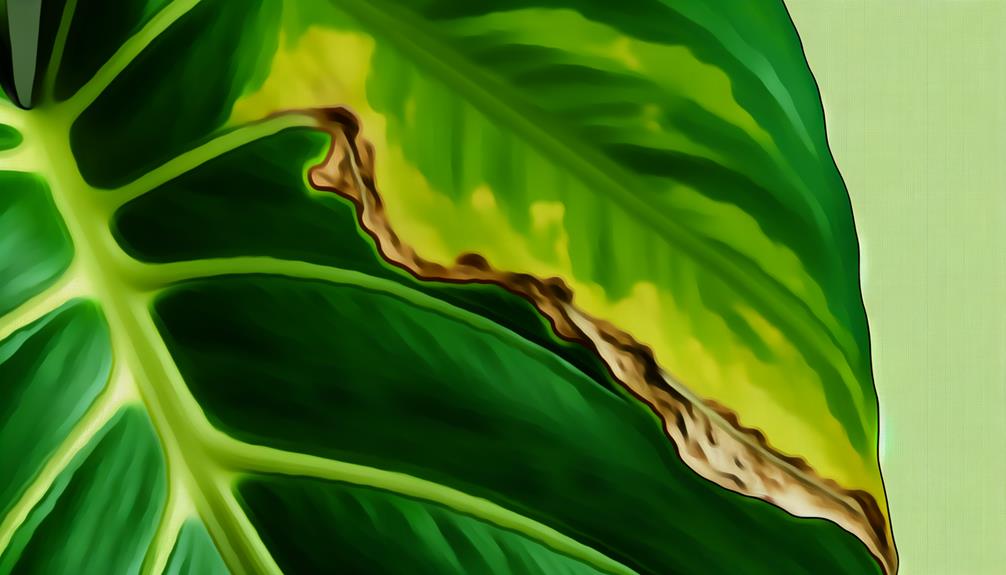
Key Takeaways
- Overwatering or underwatering can cause Philodendron Hope leaves to curl due to improper moisture levels.
- Low humidity leads to increased transpiration and leaf curling.
- Extreme temperature fluctuations can damage cells, resulting in curled leaves.
- Inadequate light affects photosynthesis, leading to pale and curled leaves.
- Pest infestations, such as spider mites or aphids, can cause leaf curling in Philodendron Hope.
Watering Issues

One of the primary causes of Philodendron Hope leaves curling is improper watering, which can manifest as either overwatering or underwatering. Overwatering leads to waterlogged soil, causing root rot, and inhibiting the plant's ability to uptake essential nutrients. This results in turgor loss and curling leaves.
Conversely, underwatering deprives the plant of necessary hydration, leading to desiccation and subsequent leaf curling as the plant attempts to minimize water loss. It is essential to maintain a balanced watering regimen, ensuring the soil is kept consistently moist but not saturated.
Monitoring soil moisture levels with a moisture meter and adjusting watering frequency based on environmental conditions can mitigate these issues, promoting healthy and robust foliage.
Humidity Levels
Fluctuations in humidity levels can impact the physiological health of Philodendron Hope, often manifesting as curling leaves when the ambient air is too dry. This tropical plant thrives in environments with consistently high humidity. When humidity drops, transpiration rates increase, leading to water loss and subsequent leaf curling as a protective response.
To maintain ideal humidity levels, consider the following:
- Humidifiers: Utilize a humidifier to maintain steady moisture levels in the air.
- Misting: Regularly mist the plant to simulate its natural habitat.
- Pebble Trays: Place the pot on a tray filled with water and pebbles.
- Grouping Plants: Cluster plants together to create a microenvironment with higher humidity.
- Room Placement: Position the plant in rooms with naturally higher humidity, such as bathrooms.
Temperature Fluctuations

Temperature fluctuations can greatly influence the physiological processes of Philodendron Hope, often resulting in curling leaves as the plant responds to sudden changes in its environment. These fluctuations can cause stress, leading to a disruption in cellular functions and water transport within the leaves. A stable temperature range is vital for maintaining ideal metabolic activities in the plant. Extreme cold can cause cellular damage, while excessive heat can lead to rapid transpiration and dehydration.
| Temperature Condition | Possible Effects on Leaves |
|---|---|
| Below 50°F (10°C) | Cellular damage, leaf curling |
| 50-60°F (10-15°C) | Reduced metabolic activity |
| 60-75°F (15-24°C) | Optimal growth |
| 75-85°F (24-29°C) | Increased transpiration |
| Above 85°F (29°C) | Dehydration, leaf curling |
Understanding these impacts can aid in creating a stable environment for your Philodendron Hope.
Light Exposure
Light exposure is a critical factor influencing the health of Philodendron Hope leaves. Both insufficient light levels and excessive direct sunlight can potentially cause curling. Inadequate light can lead to weak, elongated growth, while too much direct sunlight can result in leaf scorch and dehydration.
It is essential to adjust light conditions to make sure the plant receives bright, indirect light to maintain the best leaf health.
Insufficient Light Levels
Inadequate light exposure is a predominant factor contributing to the curling of Philodendron Hope leaves, as it impairs the plant's ability to photosynthesize efficiently. Photosynthesis is essential for the synthesis of glucose and other crucial compounds that sustain cellular functions.
When light levels are insufficient, several physiological disruptions occur, leading to leaf curling as an adaptive response to conserve energy.
Key indicators of insufficient light exposure include:
- Pale or yellowing leaves: Indicative of chlorophyll degradation.
- Slowed growth: Reduced photosynthetic activity affects overall growth rate.
- Leggy stems: Plants stretch towards available light sources.
- Leaf drop: Leaves may fall off due to stress.
- Smaller leaf size: Limited light affects leaf development.
Understanding these indicators can aid in diagnosing and rectifying inadequate light conditions.
Excessive Direct Sunlight
Excessive direct sunlight can lead to photoinhibition in Philodendron Hope, causing the leaves to curl as a protective measure against the detrimental effects of intense light exposure. This physiological response occurs due to the saturation of the plant's photosynthetic machinery, leading to a decrease in photosynthetic efficiency and potential cellular harm. The symptoms include leaf curling, discoloration, and eventual necrosis if prolonged exposure persists.
| Symptom | Cause |
|---|---|
| Leaf Curling | Photoinhibition |
| Discoloration | Chlorophyll Degradation |
| Necrosis | Cellular Damage |
| Reduced Growth | Impaired Photosynthesis |
Understanding these symptoms helps in diagnosing light-related stress in Philodendron Hope. Effective identification is essential for mitigating damage and ensuring the best plant health.
Adjusting Light Conditions
Optimizing light conditions for Philodendron Hope involves carefully calibrating the intensity and duration of light exposure to prevent stress symptoms such as leaf curling. Analyzing the plant's natural habitat, which includes filtered sunlight under dense canopies, reveals its preference for indirect light.
Overexposure to direct sunlight can cause photodamage, while insufficient light can inhibit photosynthesis, both leading to leaf curling.
To adjust light conditions effectively:
- Place the plant in a location with bright, indirect sunlight.
- Use sheer curtains to diffuse direct sunlight.
- Rotate the plant periodically to guarantee even light distribution.
- Supplement natural light with grow lights if necessary.
- Monitor the plant's response and modify as needed.
This detailed approach guarantees the Philodendron Hope thrives without stress-induced leaf curling.
Soil Conditions
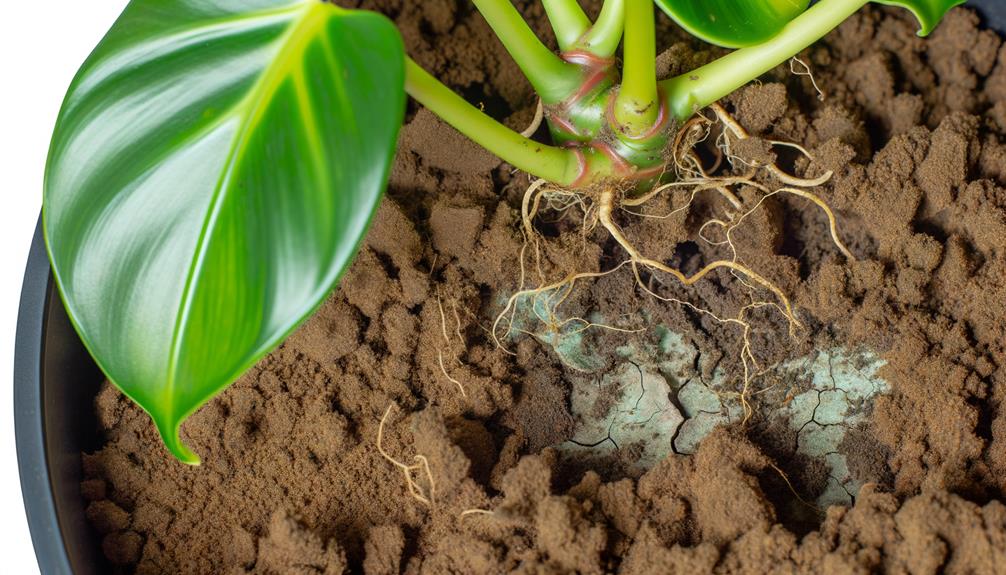
Soil conditions play a crucial role in the overall health of Philodendron Hope, directly influencing leaf morphology and vigor. Ideal soil composition must ensure sufficient drainage while retaining proper moisture levels. A well-aerated, slightly acidic to neutral soil (pH 6.0-7.0) is recommended.
Excessively compact or waterlogged soil can hinder root oxygenation, leading to root rot and subsequent leaf curling. Enhancements like perlite or peat moss improve aeration and water retention, balancing the soil's physical properties.
Additionally, monitoring salinity levels is essential, as high salt concentrations from over-fertilization or poor-quality water can disrupt osmotic balance, causing leaves to curl as a stress response. Regularly evaluating and adjusting soil conditions is crucial for maintaining the physiological health of Philodendron Hope.
Nutrient Deficiency
Nutrient deficiency in Philodendron Hope manifests through specific symptoms such as leaf curling, discoloration, and stunted growth, necessitating a thorough analysis of the plant's nutritional intake. Essential nutrients such as nitrogen, phosphorus, and potassium play vital roles in maintaining plant health. Deficiency in these elements can disrupt physiological processes, leading to visible distress signals like leaf curling.
A systematic approach to diagnosing nutrient deficiencies involves:
- Inspecting leaf color and texture: Yellowing or browning of leaves can indicate specific nutrient deficits.
- Evaluating soil pH levels: Imbalanced pH can hinder nutrient absorption.
- Examining root health: Poor root development can limit nutrient uptake.
- Assessing fertilization routine: Inadequate or excessive fertilization affects nutrient availability.
- Observing overall plant vigor: General health can provide clues to underlying deficiencies.
Understanding these factors is essential for effective remediation.
Pest Infestations
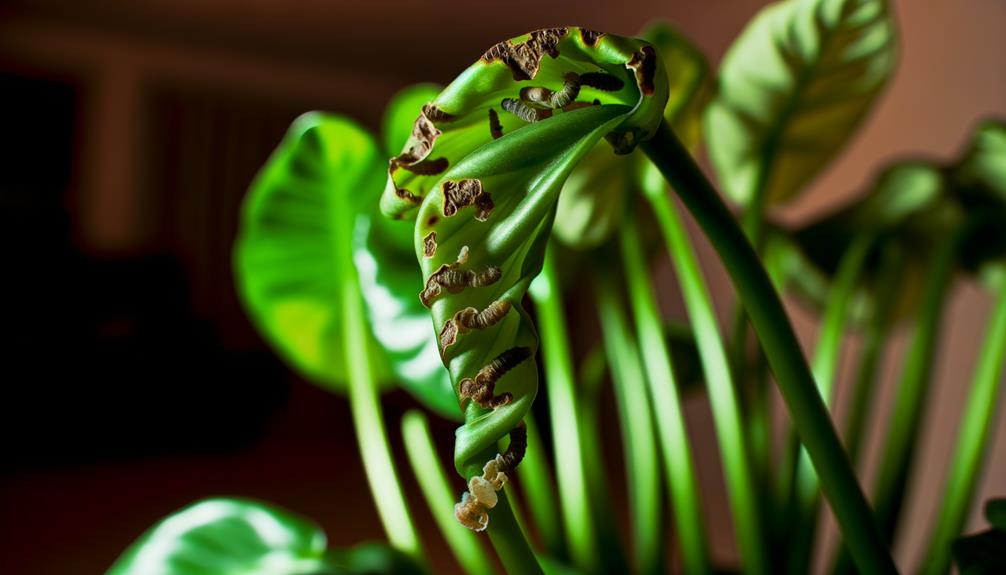
In the world of Philodendron Hope care, pest infestations represent a critical challenge, often manifesting through symptoms such as leaf curling, discoloration, and deformities. Common culprits include spider mites, aphids, and mealybugs. These pests extract plant sap, depleting essential nutrients and water, thereby inducing stress responses that cause leaf curling.
Spider mites are particularly nefarious, weaving fine webs while feeding on the undersides of leaves, leading to stippled discoloration and curling. Aphids and mealybugs secrete honeydew, fostering sooty mold growth that further impairs photosynthesis.
Early detection and intervention are paramount; regular inspection and the application of insecticidal soap or neem oil can mitigate infestations. Ensuring ideal humidity levels and cleanliness also deters pest proliferation.
Disease Problems
Disease problems in Philodendron Hope, such as bacterial leaf spot, fungal infections, and viral diseases, can greatly contribute to leaf curling.
Bacterial leaf spot, caused by Xanthomonas campestris, typically manifests as yellow or brown lesions, leading to tissue damage and subsequent curling.
Similarly, fungal infections, including those caused by pathogens like Phytophthora and Pythium, as well as viral diseases, disrupt cellular integrity and physiological processes, resulting in symptomatic leaf deformation.
Bacterial Leaf Spot
Bacterial leaf spot, caused by various pathogenic bacteria such as Xanthomonas campestris, manifests as water-soaked lesions on the leaves that can lead to significant tissue damage and curling in Philodendron Hope plants. These lesions often develop into necrotic spots, disrupting the plant's photosynthetic efficiency and overall health. The bacteria thrive in warm, humid conditions and can be spread through water splashes, contaminated tools, or infected plant material.
Key management strategies include:
- Proper sanitation: Regularly sterilize tools and remove affected plant parts.
- Watering practices: Avoid overhead watering to minimize leaf wetness.
- Environmental control: Ensure good air circulation to reduce humidity.
- Chemical treatments: Use bactericides as a preventive measure.
- Quarantine: Isolate new or symptomatic plants to prevent spread.
Understanding these strategies is essential for maintaining plant health.
Fungal Infections
While bacterial leaf spot poses a significant threat to Philodendron Hope, fungal infections equally compromise plant health by inducing leaf curling, discoloration, and tissue necrosis. Common fungal pathogens such as Phytophthora, Pythium, and Fusarium species invade plant tissues, disrupting normal physiological processes. These fungi thrive in excessively moist environments, often facilitated by poor drainage and high humidity.
Initial symptoms include yellowing or browning of leaves, followed by curling as the plant attempts to reduce surface area exposed to infection. Advanced stages may show blackened, necrotic tissue. Effective management requires prompt identification, improved air circulation, and the application of fungicidal treatments.
Regularly inspecting plants and maintaining ideal growing conditions are critical preventive measures against these pervasive fungal threats.
Viral Diseases
Viral diseases in Philodendron Hope manifest through a range of symptoms including leaf curling, mosaic patterns, and stunted growth, disrupting the plant's normal cellular functions and overall health. These viral pathogens infiltrate plant cells, hijacking their machinery to propagate, which leads to visible and detrimental effects on the foliage. The transmission of viral diseases often occurs through insect vectors, contaminated tools, or infected plant material. Diagnosis can be challenging, necessitating laboratory tests for accurate identification.
Key symptoms and factors include:
- Leaf Curling: Distortion of leaf shape due to cellular malfunction.
- Mosaic Patterns: Irregular coloration and patchiness on leaves.
- Stunted Growth: Reduced overall plant vigor and size.
- Vector Transmission: Spread primarily by insects like aphids.
- Diagnostic Challenges: Often requires molecular techniques for confirmation.
Understanding these aspects is vital for effective management and prevention.
Conclusion
To sum up, the curling of Philodendron Hope leaves can be attributed to a myriad of factors including improper watering, insufficient humidity, temperature fluctuations, inadequate light exposure, suboptimal soil conditions, nutrient deficiencies, pest infestations, and disease issues. Each factor exerts a unique influence on the plant's physiological state, necessitating a rigorous and systematic approach to diagnosis and remediation.
Addressing these variables with careful attention will guarantee the health and aesthetic splendor of the Philodendron Hope, akin to preserving a time-honored botanical relic.

